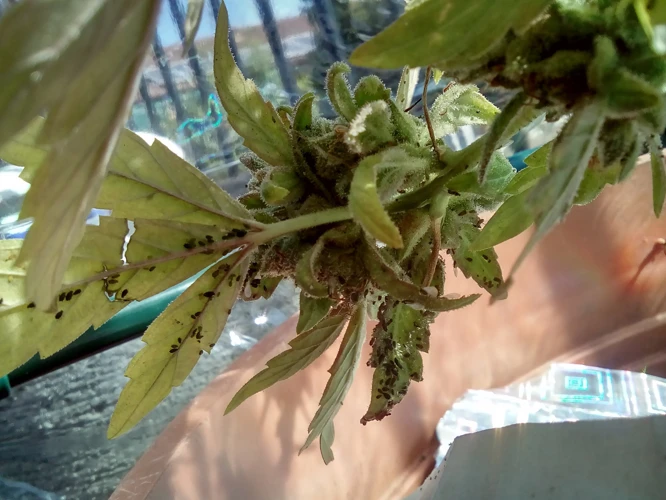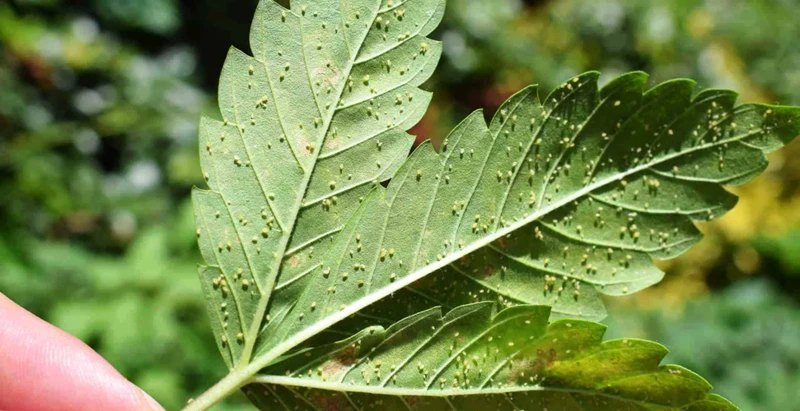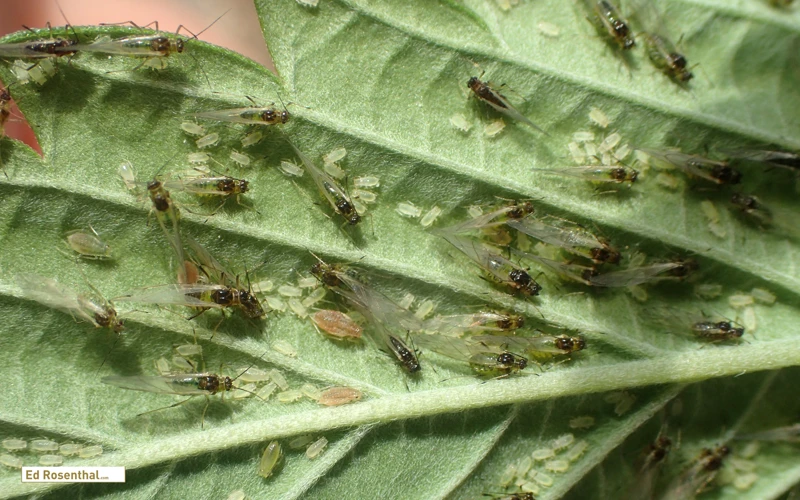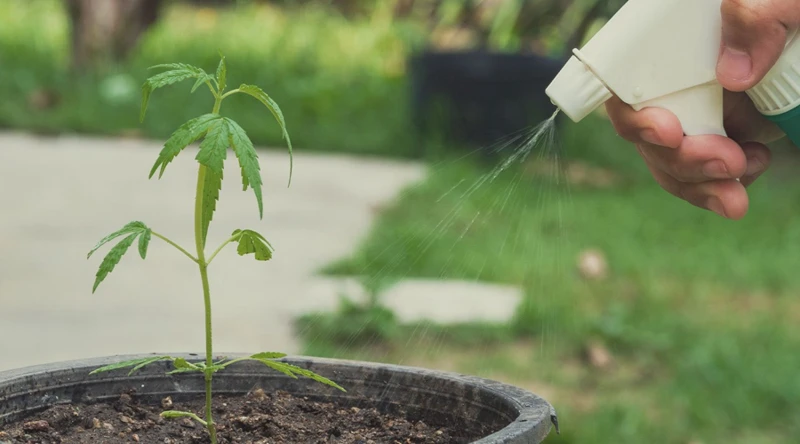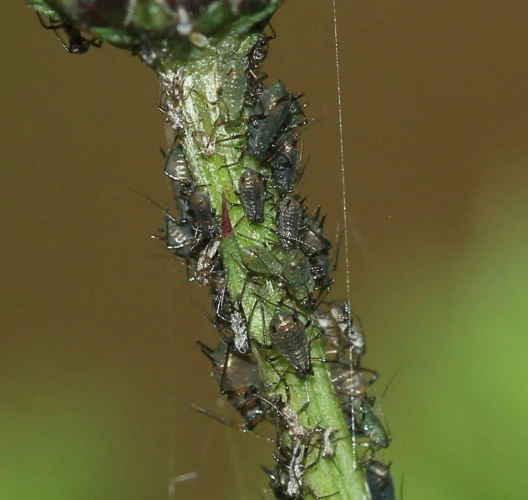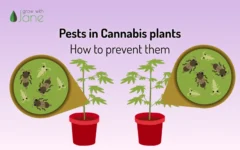
Effective Strategies for Controlling Aphids in Your Cannabis Garden
As a cannabis gardener, one of the biggest challenges that you may encounter are pest infestations. One of the most common pests that can wreak havoc on your cannabis plants are aphids. These tiny insects are not only unsightly, but they can also cause irreversible damage to your crop if left unchecked. If you’ve ever experienced an aphid infestation, you know just how frustrating it can be to get rid of them. Fortunately, there are several effective methods for controlling aphids in your cannabis garden. In this article, we will explore these methods, from prevention to natural and chemical control options, and help you steer clear of future aphid troubles.
Identifying Aphids
Contents
One of the biggest challenges that cannabis gardeners face is the threat of pests, and aphids are one of the most common. Aphids are small, sap-sucking insects that can quickly overwhelm a plant and cause significant damage. It’s crucial to identify an aphid infestation as early as possible so you can take steps to control it. In this section, we will discuss how to identify aphids, including their appearance and behavior, so you can take action and keep your cannabis plants healthy. For more information on organic pest control in cannabis gardens, visit our article here.
Appearance
Aphids are small, soft-bodied insects that can range in color from green to black, or even white or yellow. They have a distinct pear-shaped body with a narrow waist and long antennae. Some species have wings while others do not. In their nymph stage, they resemble smaller versions of the adult aphid.
Here are some key features to look for when identifying aphids:
- Size: Aphids are typically only a few millimeters in length, and most are smaller than 1/8 of an inch.
- Shape: Their bodies are pear-shaped and have a distinct, pointed “tail” or cornicles on their rear end.
- Color: Depending on the species, aphids can be green, black, white, or yellow. Some may have brown or reddish tones as well.
- Antennae: Aphids have long, thin antennae that can be as long as their body.
- Legs: They have six spindly legs that are often difficult to see.
- Wings: Some aphid species have wings that are either clear or opaque and often extend beyond the length of their body.
It’s important to note that aphids can vary in appearance depending on their species and stage of development. However, their pear-shaped body and cornicles on their rear end are key identifying features. By understanding aphid appearance, cannabis gardeners can better identify and control aphid infestations.
Behavior
Aphids can be very damaging to cannabis plants due to their feeding behavior. They feed on the sap of the plant by piercing the leaves with their mouthparts. As they feed, they secrete a sticky substance called honeydew. This substance can cause fungal growth and attract other pests to the plant.
Aphid Behavior:
| Behavior | Description |
|---|---|
| Feeding | Aphids feed mainly on the phloem sap of the plant. They use their sharp mouthparts to pierce the plant tissue and extract the sap. |
| Reproduction | Aphids reproduce quickly and in large numbers. Females can give birth to up to 12 live nymphs per day without mating. |
| Mobility | Aphids are slow-moving pests and cannot travel long distances on their own. However, they can be carried by wind or on the bodies of other insects. |
It is important to monitor the behavior of aphids in cannabis gardens to identify and control infestations early. Feeding behavior can lead to stunted growth, wilted leaves, and deformed flowers. Reproduction behavior can lead to a rapid explosion in the population of aphids. Mobility behavior can lead to the spread of infestations to nearby plants. By understanding aphid behavior, gardeners can implement effective control measures to protect their cannabis plants.
The Dangers of Aphids in Cannabis Gardens
Aphids, also known as plant lice, are a considerable threat to cannabis gardens. These tiny insects may seem harmless, but they can cause serious damage to cannabis plants if left unchecked. Some of the dangers posed by aphids include plant deformity, stunted growth, yellowing or browning of leaves, and significant yield reduction.
One of the biggest threats posed by aphids is their ability to quickly reproduce and spread throughout a cannabis garden. Female aphids can produce up to 12 offspring per day, and these offspring can quickly mature and start reproducing themselves. This can lead to a rapid infestation that can be difficult to control.
Aphids also have the ability to transmit plant viruses, which can have a devastating impact on cannabis plants. Some of the viruses that aphids can transmit include cucumber mosaic virus, tomato mosaic virus, and potato virus Y. Once infected, cannabis plants may experience a range of symptoms, such as stunted growth, mottled leaves, and reduced yield. In severe cases, infected plants may even die.
Another danger associated with aphids is their attraction to sticky secretions produced by cannabis plants, known as honeydew. Honeydew can attract other pests such as ants, which can also harm cannabis plants by damaging roots and spreading plant diseases.
The presence of aphids in a cannabis garden can have significant negative effects on plant health and yield. It is important to take steps to prevent and control aphid infestations to minimize the risks they pose to cannabis plants.
Preventing Aphid Infestations
Keeping aphids away from your cannabis garden is essential in ensuring a successful harvest. Nothing can be more perplexing than discovering a new infestation of these pests, which can spread quickly and damage your precious plants in no time. Implementing a proactive approach towards preventing aphid infestations is highly recommended, and there are several steps you can take to ensure that your garden always stays aphid-free. By following a few simple guidelines, you can keep your cannabis garden thriving throughout the growing season, and protect your plants from unwanted aphid attacks.
Cleanliness
Maintaining cleanliness in your cannabis garden is an effective way to prevent and control aphid infestations. Here are some steps to follow for a clean garden:
- Remove any fallen debris around the plants: Aphids are attracted to decaying organic matter, so removing fallen leaves and other plant waste from the ground will help reduce the chances of an infestation.
- Regularly clean and sanitize your greenhouse or indoor grow space: Aphids can easily spread from plant to plant, so keeping your grow space clean is essential. Regularly wipe down surfaces and equipment with a disinfectant solution to kill any lingering aphids or eggs.
- Prune affected plants: If you notice that some of your plants are already infested with aphids, prune them immediately to prevent the infestation from spreading. Cut off the affected leaves or stems and dispose of them properly away from the garden area.
- Regularly inspect plants: Inspect your plants regularly for any signs of aphid infestation. Look for small, pear-shaped bugs clustered around the stems, leaves, and buds of your plants.
- Avoid over-fertilizing: Overuse of fertilizer can weaken the plants and attract aphids. Make sure to follow the recommended fertilization schedule and dosage for your cannabis plants.
By following these cleanliness practices, you can greatly reduce the probability of an aphid infestation in your cannabis garden.
Maintaining Plant Health
One of the most effective ways to prevent aphid infestations in your cannabis garden is by maintaining plant health. When your plants are healthy and strong, they are less likely to become a target for aphids. Here are some tips to help you maintain plant health:
| Tips for Maintaining Plant Health |
|---|
| Proper watering: Over-watering can lead to root rot and create an environment that is favorable for pests. Water your plants only when needed, and make sure the soil is well-draining. |
| Nutrient balance: Make sure your plants are getting the nutrients they need to grow strong and healthy. Use a high-quality fertilizer that is specifically formulated for cannabis and follow the manufacturer’s instructions for application. |
| Good air circulation: Good air circulation is important for preventing mold and fungal growth. Make sure your grow room or greenhouse has proper ventilation and use fans to keep the air moving. |
| Proper lighting: Cannabis plants need a lot of light to grow, but too much or too little can be harmful. Make sure your plants are getting the right amount of light for their stage of growth and adjust as needed. |
| Proper pruning: Regular pruning can help prevent overcrowding and allows for better air circulation. It also helps to remove any diseased or damaged leaves or branches. Make sure to use clean pruning tools to avoid spreading pests or disease. |
By following these tips for maintaining plant health, you can create an environment that is less attractive to aphids and other pests. Additionally, healthy plants are more resilient and will be better equipped to fight off any potential infestations.
Natural Methods for Control
When it comes to controlling aphids in your cannabis garden, natural methods can be a safe and effective solution. These methods use natural substances or predators to deter or eliminate aphids, without relying on harsh chemicals that can harm both the environment and your plants. In this section, we will explore several natural methods for controlling aphids in your cannabis garden, including the use of beneficial insects, neem oil, diatomaceous earth, and pyrethrin insecticide. By using these methods, you can protect your plants while promoting a healthy and sustainable growing environment.
Beneficial Insects
One effective natural method for controlling aphids in cannabis gardens is by introducing beneficial insects. These insects are natural predators of aphids and can help reduce their population in a safe and environmentally-friendly way. Here are some examples of beneficial insects that can be introduced to a cannabis garden:
| Insect | Description |
|---|---|
| Ladybugs | These insects are perhaps the most well-known natural predator of aphids. Ladybugs will consume not only aphids but also other common cannabis pests like spider mites and whiteflies. They can be introduced to a garden by purchasing them online or at a local nursery. |
| Lacewings | These insects have a unique appearance with delicate and intricately-patterned wings. Like ladybugs, they consume a variety of common cannabis pests including aphids. Lacewings can be purchased from nurseries or through online retailers. |
| Hoverflies | Hoverflies are another natural predator of aphids. They are small and resemble bees, but do not sting. Hoverflies can be attracted to the garden by planting flowers like marigolds, alyssum, and daisies. |
Introducing beneficial insects to a cannabis garden requires some planning and care. It’s important to make sure that the garden is hospitable to these insects by avoiding the use of harmful pesticides and providing plenty of food, water, and habitat. Additionally, it’s important to research the specific needs and behaviors of each insect before introducing them to the garden. By taking these precautions and introducing beneficial insects, cannabis growers can reduce aphid populations in a safe and effective way.
Neem Oil
Neem oil is a natural and effective remedy for controlling aphids in cannabis gardens. This oil is derived from the seeds of the neem tree and contains azadirachtin, which is a natural insecticide. The use of neem oil to control aphids is an environmentally friendly alternative to the use of synthetic chemicals.
| Pros | Cons |
|---|---|
| -Effective in controlling aphids | -May need to be reapplied frequently |
| -Safe for use on edible plants | -Strong odor that may linger in the garden |
| -Does not harm beneficial insects | -May cause skin and eye irritation if not used properly |
| -Easy to apply with a spray bottle | -May take longer to see results compared to synthetic chemicals |
When using neem oil, it is important to follow the manufacturer’s instructions for dilution and application. Typically, neem oil is mixed with water and applied to the leaves of the cannabis plant using a spray bottle. It is recommended to apply neem oil in the early morning or late evening to avoid direct sunlight, as this may cause leaf burn.
One advantage of using neem oil is that it does not harm beneficial insects such as ladybugs and lacewings, which are natural enemies of aphids. However, it is important to note that neem oil may need to be reapplied frequently, especially after rain or watering, to maintain its effectiveness.
Another consideration when using neem oil is its strong odor, which may linger in the garden. It is important to use neem oil in a well-ventilated area and avoid spraying it near windows or doors.
Neem oil is a natural and effective way to control aphids in cannabis gardens. It is important to use it properly and follow the manufacturer’s instructions for the best results.
Diatomaceous Earth
Diatomaceous Earth, also known as DE, is a natural substance that consists of the remains of diatoms, aquatic organisms that have silica shells. It comes in a powder form and is a popular choice for controlling aphids in cannabis gardens due to its effectiveness and safety.
| Pros | Cons |
| — | — |
|Non-toxic: DE is safe for plants and animals, making it an eco-friendly option for controlling aphids.|Dry conditions: DE needs to be dry to be effective, which can be challenging in humid environments.|
|Physical barrier: DE works by creating a physical barrier that suffocates the aphids, leading to their eventual death.|Thorough application: It’s important to apply DE thoroughly to ensure all aphids are exposed to the powder.|
|Long-lasting: Once applied, DE can provide protection for up to 3 weeks.|Not selective: DE can harm beneficial insects as well as harmful ones.|
To use DE for controlling aphids, simply sprinkle the powder onto affected plants or directly onto the aphids themselves. It’s important to apply the powder evenly and thoroughly to ensure all aphids are exposed to the powder. Additionally, it’s best to apply DE when the plants are dry to ensure maximum effectiveness.
While DE is generally safe, it’s still important to wear protective clothing and a mask when applying it to avoid inhalation. It’s also important to note that DE can harm beneficial insects such as ladybugs and praying mantises, so it’s important to use it judiciously and only when necessary.
Pyrethrin Insecticide
Pyrethrin insecticide is another effective natural solution for controlling aphids in a cannabis garden. It is a biodegradable substance derived from the dried flowers of the chrysanthemum plant. Pyrethrin insecticide is safe to use on your plants and does not leave harmful residue.
Advantages
– Pyrethrin insecticide is a natural and organic method for controlling aphids in your garden.
– It is considered safe for humans, pets, and the environment.
– It quickly immobilizes and kills aphids on contact.
Disadvantages
– It is not specific to aphids and can harm beneficial insects.
– It has a short lifespan and needs to be reapplied frequently.
– Aphids can develop resistance to the active ingredient in pyrethrin insecticide over time.
Application
Pyrethrin insecticide can be applied in two ways: as a foliar spray or as a dust. In both cases, it is important to cover all parts of the plant, as aphids can hide in hard-to-reach areas like the undersides of leaves.
| Application Method | Instructions |
|---|---|
| Foliar Spray |
1. Mix Pyrethrin insecticide according to package instructions 2. Spray the solution onto the affected plants, making sure all parts are covered 3. Repeat the application every 5-7 days until the aphids are under control |
| Dust |
1. Dust the Pyrethrin insecticide powder onto the affected plants 2. Gently shake the plant to ensure the powder covers all parts 3. Repeat the application every 5-7 days until the aphids are under control |
When using pyrethrin insecticide, it is important to follow the package instructions carefully and wear protective clothing, gloves, and eye protection. This will prevent unnecessary exposure to the substance. Additionally, it is important to reapply the insecticide frequently to ensure that the aphids do not become resistant to it.
Chemical Treatments for Control
While natural methods for controlling aphids in a cannabis garden are ideal, sometimes a more aggressive approach is necessary. In such cases, chemical treatments can be effective in eliminating an infestation. However, it is important to approach chemical solutions with caution, as they may have harmful effects on both the environment and your plants. It is crucial to choose the right pesticides and application techniques, and to be mindful of the potential risks involved. In this section, we will explore the use of chemical treatments for controlling aphids in your cannabis garden.
Choosing the Right Pesticides
When it comes to choosing the right pesticides to control aphids in your cannabis garden, there are several important factors to consider:
- Effectiveness: Look for a pesticide that specifically targets aphids and has been proven effective in controlling these pests.
- Safety: Always choose pesticides that are safe for use on cannabis plants and won’t leave harmful residues on your buds.
- Mode of action: Some pesticides work by contact, meaning they must come into direct contact with the insect to kill it. Others work systemically, meaning they are absorbed by the plant and kill insects that feed on it.
- Application method: Choose a pesticide that can be easily applied to your plants, whether through foliar spray, soil drench or another method that suits your needs.
- Timing: It’s important to apply pesticides at the right time to ensure maximum effectiveness. For example, some pesticides should be applied during the early stages of an infestation, while others are more effective later on.
- Resilience: Consider whether the pesticide you choose will continue to be effective even with repeated use.
By carefully considering these factors, you can choose a pesticide that is both effective and safe for controlling aphids in your cannabis garden. Remember to always read and follow the label instructions carefully, and never use more pesticide than is recommended.
Application Techniques
When it comes to chemical treatments for controlling aphids in a cannabis garden, the correct application techniques are essential. Here are some helpful tips to follow:
- Read the label: Always read the label of any pesticide before using it. The label contains important information about proper application, dosage, and safety precautions that must be followed.
- Timing: Timing is crucial when it comes to applying pesticides. Apply pesticides in the early morning or late evening, when temperatures are cooler and the plants are less stressed. Avoid applying pesticides during the heat of the day, as this can cause damage to the plants.
- Do not overuse: Overusing pesticides can harm both the plants and beneficial insects. Apply only as much pesticide as recommended, and use only when necessary to control an infestation.
- Application method: Different pesticides have different application methods. Some pesticides are applied as a spray, while others are applied as a drench or soil treatment. Always follow the recommended application method for the specific pesticide being used.
- Protect yourself: When applying pesticides, be sure to wear protective clothing, including long sleeves, pants, gloves, and a mask. Keep people and pets out of the area until the pesticide has dried or as recommended on the label.
- Washing plants: After applying pesticides, it is important to wash the plants with water to remove any residue. This will help prevent harmful chemicals from being ingested or inhaled.
- Follow up: Even if the aphid infestation appears to be under control, it is important to follow up with additional treatments as recommended on the label. This will help ensure long-term control and prevent the infestation from returning.
By following these application techniques, you can safely and effectively control aphids in your cannabis garden with chemical treatments. However, it is important to remember that natural methods should always be the first line of defense, and that pesticides should only be used as a last resort.
Using Traps to Control Aphids
When it comes to controlling aphids in a cannabis garden, using traps can be an effective and eco-friendly method. Traps work by luring and capturing aphids, preventing them from causing damage to your crops. In this section, we will explore different types of traps that can be used to control aphids, their benefits, and how to use them properly. Let’s dive into the world of aphid traps and discover how they can help protect your cannabis plants.
Yellow Sticky Traps
One effective way to control aphids in cannabis gardens is by using yellow sticky traps. These traps are made by coating yellow index cards or strips with a sticky substance that will trap aphids when they come in contact with it.
Advantages of Yellow Sticky Traps
Using yellow sticky traps to control aphids has several advantages, such as:
| Advantages | Explanation |
| Non-toxic | Yellow sticky traps do not require the use of chemicals, making them a safe and natural option for controlling aphids. |
| Easy to use | Simply hang the traps near the cannabis plants to be protected and wait for aphids to be caught. |
| Cost-effective | Yellow sticky traps are an inexpensive option and can be made at home using simple materials. |
| Effective | Yellow sticky traps are an effective way to monitor and control aphid populations in cannabis gardens. |
Using Yellow Sticky Traps Effectively
To use yellow sticky traps effectively, follow these tips:
- Hang the traps near the cannabis plants to be protected, making sure they are at the same height or slightly higher than the plants.
- Replace the traps regularly, as they can become covered in debris or lose their stickiness over time.
- Use enough traps to cover the entire garden, with at least one trap per plant.
- Monitor the traps regularly for aphids, and remove any trapped insects before they become a breeding ground for other pests.
- Combine yellow sticky traps with other natural methods for control, such as beneficial insects or neem oil, for maximum effectiveness.
Yellow sticky traps are a safe, easy, and cost-effective way to control aphids in cannabis gardens. By using them properly and in combination with other methods, growers can prevent infestations and maintain healthy, productive plants.
Aphid-Specific Traps
Aphid-specific traps are a great option for controlling aphids in cannabis gardens. These traps, which are specifically designed to attract and catch aphids, can be very effective in reducing the population of these annoying pests. There are a few different types of aphid-specific traps available, each with their own unique advantages.
Here are some types of aphid-specific traps:
- Yellow Water Traps: These traps use yellow-colored water to attract aphids, which then become stuck in the liquid and drown. They are easy to make at home with yellow plastic cups filled with water and a few drops of dish soap. Hang the cups in the garden next to infected plants to trap aphids.
- Sticky Traps: Sticky traps are another effective option for aphid control. These traps use a sticky substance coated on bright yellow or blue paper or cardboard to trap the insects. Simply hang the traps near the infested plants and the sticky surface will trap the aphids as they fly by.
- Pheromone Traps: These traps use aphid pheromones to attract and trap the pests. They are most effective when used in combination with other control methods.
It is important to note that aphid-specific traps should never be used as the sole method of control. They are most effective when used in combination with other natural or chemical methods. Additionally, traps should be monitored and replaced frequently to ensure they are working effectively.
Important Considerations When Controlling Aphids
As a cannabis gardener, controlling aphids is crucial to ensure the health and productivity of your plants. However, it’s important to be mindful of the methods you use and the potential harm they may cause to your crops, the environment, and other organisms. In this section of the article, we will discuss some important considerations to keep in mind when controlling aphids in your cannabis garden, including avoiding toxicity and implementing monitoring and prevention measures. By taking these factors into account, you can effectively combat aphid infestations while also maintaining the integrity of your garden’s ecosystem.
Avoiding Toxicity
When it comes to controlling aphids in cannabis gardens, it’s important to keep in mind the potential toxicity of the chemicals and treatments used. To avoid harming the plants, the environment, and yourself, it is essential to take the necessary precautions to minimize exposure to toxic substances. Here are some tips on how to avoid toxicity during aphid control:
- Read the Label: Always read the label of any pesticides or treatments you use. Follow the manufacturer’s instructions carefully and use the recommended precautions.
- Avoid Harsh Chemicals: Whenever possible, use natural or organic methods to control aphids. Harsh chemicals can not only harm the aphids but also the beneficial insects that help control them.
- Protect Yourself: Wear protective clothing, gloves, and a mask when applying pesticides or treatments. This will minimize the risk of exposure.
- Cover Your Face: When applying any treatments or spraying pesticides, avoid inhaling the fumes. Cover your face with a mask, scarf or bandana.
- Avoid Contact: Try to avoid touching the plants right after application to reduce the risk of absorbing toxins through the skin.
- Dispose Safely: After using any chemicals or treatments, dispose of them safely. Follow the instructions on the label for the proper disposal of pesticides, containers and other materials.
- Test Before Use: Before applying any new treatment or product, test it on a small area first to ensure it won’t harm the plants or cause damage.
By following these tips, you can minimize the risk of toxicity and ensure the health and safety of your plants and yourself. Remember, prevention is key, so regular monitoring and prevention methods will help keep aphids under control and reduce the need for toxic treatments.
Monitoring and Prevention
Monitoring and Prevention
One of the most important things you can do to prevent an aphid infestation is to monitor your cannabis plants regularly. This means checking for signs of aphid activity, such as discolored leaves or sticky honeydew residue. It’s also crucial to keep an eye out for beneficial insects that may already be in your garden, such as ladybugs or lacewings, as these can help keep aphid populations under control.
Another key aspect of monitoring your plants is to pay close attention to their overall health. Plants that are stressed or weak are more susceptible to aphid infestations, so it’s essential to maintain proper growing conditions, including adequate water, light, and nutrients.
In addition to monitoring, there are several prevention measures you can take to minimize the risk of aphid infestations. These include:
- Planting companion plants that repel aphids
- Using reflective mulch to deter aphids from finding your plants
- Using row covers to physically block aphids and other pests from your plants
- Applying organic insecticides preventively before you spot any aphid activity
- Maintaining a clean growing environment by removing dead plant matter and debris
- Quarantining new plants before introducing them to your garden, to prevent introducing aphids and other pests
By implementing these preventative measures and closely monitoring your plants, you’ll be able to catch any aphid activity early and take action to prevent a full-blown infestation.
Conclusion
In conclusion, controlling aphids in a cannabis garden may seem daunting, but there are various effective methods for preventing and treating infestations. Maintaining plant health and cleanliness practices can go a long way in avoiding aphids altogether. However, if aphids do appear, natural methods such as introducing beneficial insects, using neem oil or diatomaceous earth, or applying pyrethrin insecticide can be effective in combatting these pests.
While chemical treatments are available, it’s important to choose the right pesticides and apply them correctly to avoid toxicity to both the cannabis plants and the environment. Another option for control is using traps, such as yellow sticky traps or aphid-specific traps, which can be a great addition to other treatments.
Most importantly, monitoring and prevention are crucial in controlling aphids in a cannabis garden. Regularly inspecting plants for signs of infestation and implementing preventative measures can help avoid an aphid outbreak in the first place.
Overall, with the proper knowledge and tools, it is possible to effectively control aphids and maintain healthy cannabis plants. Don’t let these pests take over your garden, take action to prevent and treat aphid infestations for a successful cannabis harvest.
Frequently Asked Questions
What are aphids?
Aphids are tiny soft-bodied insects that commonly infest gardens and cannabis plants. They feed by sucking the sap from the leaves, stems, and buds of plants, causing damage and stunting their growth.
How do I identify aphids?
Aphids can be identified by their small size, soft bodies, and various colors such as green, brown, or black. They have a pear-shaped body and long antennae.
What damage do aphids cause in cannabis gardens?
Aphids can cause significant damage to cannabis plants by feeding on their sap and secreting a sticky substance that can attract mold and other harmful insects. They also transmit viruses that can lead to plant death.
What are some natural methods for controlling aphids?
Natural methods for controlling aphids include introducing beneficial insects, using neem oil or diatomaceous earth, and applying pyrethrin insecticide.
What are some chemical treatments for controlling aphids?
Chemical treatments for controlling aphids include applying pesticides that are specifically formulated for use on cannabis plants. It is essential to choose the right pesticide and apply it correctly to avoid damaging the plant and harming the environment and human health.
How can I prevent aphid infestations in my cannabis garden?
You can prevent aphid infestations in your cannabis garden by practicing cleanliness, maintaining plant health, and using natural or chemical control methods. Regularly inspect your plants and avoid bringing in contaminated plant material from outside sources.
What are yellow sticky traps, and how do they work?
Yellow sticky traps are adhesive panels that attract aphids and other flying pests. When the pests land on the sticky surface, they get trapped and cannot escape.
What are aphid-specific traps, and how do they work?
Aphid-specific traps are small, cone-shaped devices that contain a pheromone lure that attracts aphids. When the aphids enter the trap, they become stuck on the adhesive surface and cannot escape.
How can I avoid toxicity when using pesticide treatments?
You can avoid toxicity when using pesticide treatments by carefully following the instructions on the label, wearing protective clothing and equipment, applying the pesticide in a well-ventilated area, and keeping people and pets away from the treated area for the specified time.
How often should I monitor my cannabis plants for aphids?
You should monitor your cannabis plants for aphids regularly, at least once a week, to detect any signs of infestation early and take action promptly.

